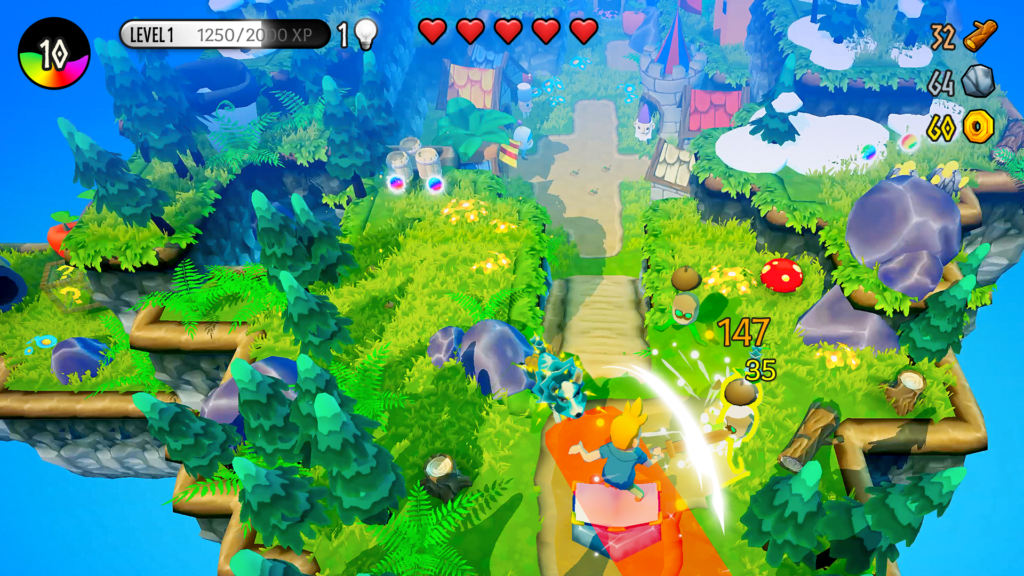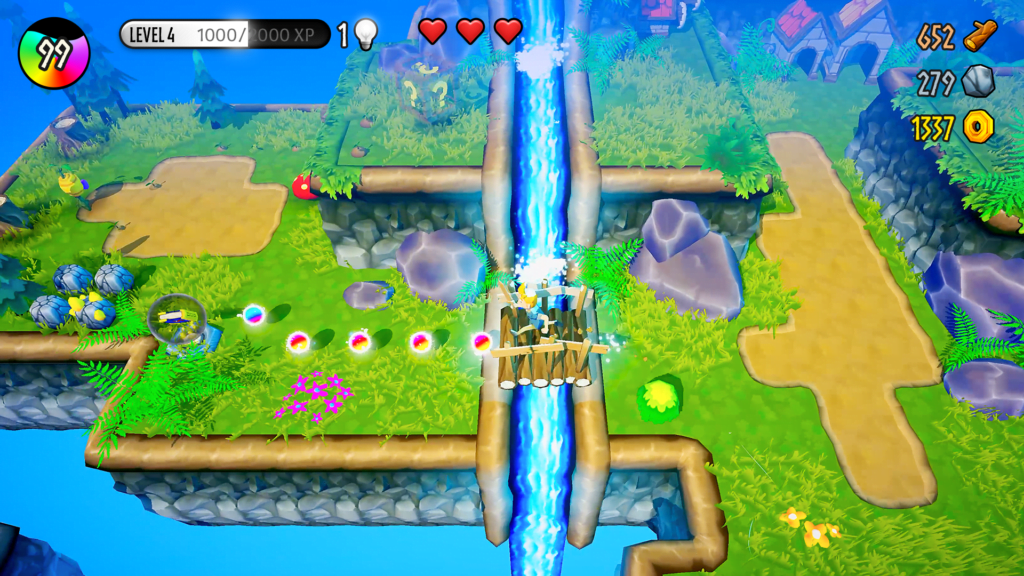A powerful force shatters the imagination core from Nor’s Headland. He has to find the fragments and fight to regain his limitless creativity with his robot friends. An ARPG with a lovely touch and feel, just a tad short. Time to dive in!
Headland
Headland is a fantastical imaginary world filled with vibrant colors and silly creatures. In it, you fight a host of monsters with fast-paced but accessible controls. Journey through a story full of vivid characters and explore a beautiful imaginary world with lush meadows, deep caves, and dark castles. Make friends along the way and confront your fears in a bit of adventure about a big imagination. And little it is since you can complete the game in a total of 5 hours (not talking about 100% it, but story-wise, for sure).
The game kicks off with Nor diving through a portal in his bedroom into his imagination. Here, he meets various robot friends, particularly a spunky robot named Spud, who is living his best life. At least, he is until a horrible worm monster appears and steals his imagination core, breaking it into five pieces and scattering them throughout Headland. Since it’s a short story, I will not spoil too much about it, since it deserves a playthrough by you – the person reading this review.
Open World versus Guided Gameplay
The game feels somewhat open in that you can roam around at will, but there are specific tasks that you need to accomplish which are pretty guided. You begin in a location called the Robot Raft, a flying fortress pilot you’ll inhabit by robots. In particular, you’ll find a blacksmith robot here who will forge new weapons for you or upgrade your existing weapons. To afford upgrades, you need to collect resources. These are scattered throughout the map in the form of objects like logs, stumps-you’ll rock. When you attack these objects, you’ll gather wood, stone, or gold from them, which you can then use to pay the blacksmith. As you progress through the game, you’ll unlock new weapons over time, and you’ll need to choose when to buy a new weapon rather than upgrading one of your existing ones.
During your playthrough, you come across gnomes and other magical creatures, straight out of Hans Christian Anderson’s fairytales. While journeying through the magical world, you guide Nor on his journey to unlock new weapons in arenas and upgrade them at the living forge using resources gathered. Sadly one of my arenas was bugged and didn’t spawn any enemies. I have yet to restart the game and check if that solves it (I carried on for the sake of the review). Just like in any other ARPG, you can define your playstyle and grow empowered as you invest in your favorite weapons. I preferred the shovel since it hit many enemies in one strike – and the pale knights you have to face often come in numerous waves. Another nifty in-game ability is the shield, which powers up by defeating enemies. The shield is quite strong and feels a bit overpowered early on. As you get further into the game, though, it starts to feel like a more balanced tool while combatting growing enemy forces. It certainly saved my ass more than once.
Do you want to hear a secret?
Like most ARPG-type games, each location has between one and three “secrets,” which are hidden areas that give you prizes but aren’t required to progress in the game. The secrets aren’t complicated to find, but you will need to employ some extra curiosity like wandering into houses for no reason or running into walls to make sure they’re walls. I like that Headland tells you the number of secrets and whether or not you’ve found them when you’re looking at a location from the world map. This gives you a proper sense of whether you’ve fully explored the game without making you waste time checking for hidden places after you’ve already found them all. I’m confident players that like games like Spyro, Crash (or even Super Lucky Tales) might enjoy this feature.
Another point of praise goes to its difficulty setting. I often pick up games that challenge me to the bones, but I also like to unwind with games like Headland. A feature I loved in Diablo and Torchlight (which it takes after, in a child-friendly way) is the death-mechanic. When you die in Headland, you lose some resources and are sent back to your last checkpoint. However, checkpoints are scattered throughout the game, so as long as you’re hitting them with your weapon when you walk by, you’ll rarely be sent back a significant amount. From there, you can return to wherever you lost your life and generally pick up the fight right where you left off — including that the enemies you already killed will still be dead. You can even find the gravestone which marks where you last died and attack it to reveal some extra enemies. Killing them will give you back most of the lost resources upon your death. So, no more grinding for wood, stone, or gold!
Conclusion
So, to conclude, I found Headland to be a fantastic game. Everything breathes charming storytime, straight out of Denmarks’ book of fairytales. Headland is another game that proves that iOS games can be reworked for the Nintendo Switch and conquer our hearts with a combination of great examples of indie gaming done right. Even though it’s a bit short, I’m putting this one on my Indie Shortlist for 2022.





